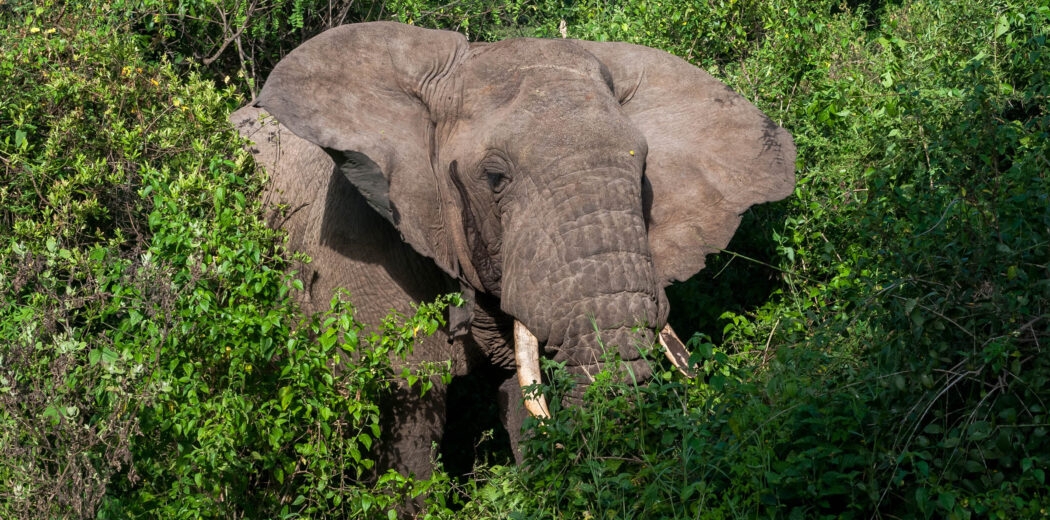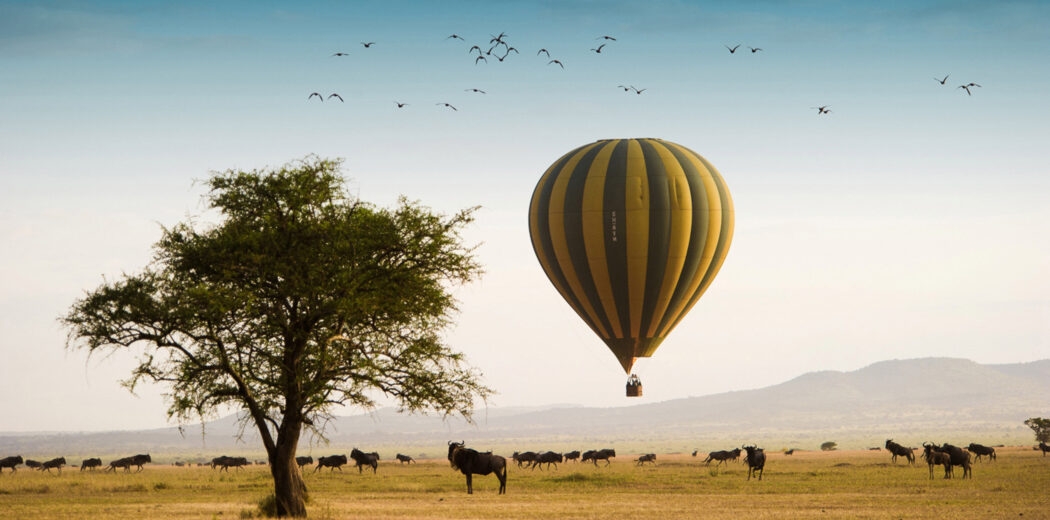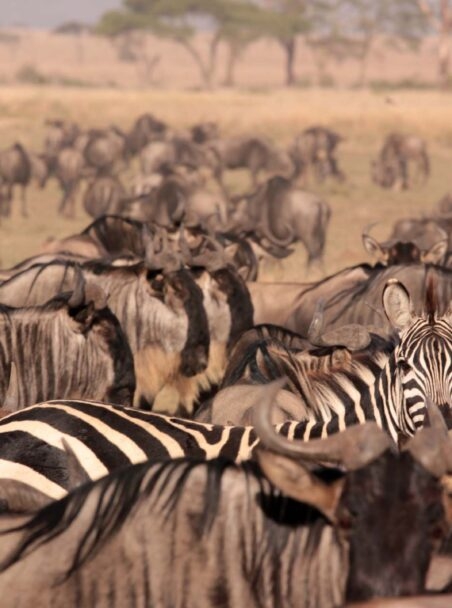Tanzania is a land of endless enchantment, from the snowy peak of Mount Kilimanjaro to the sandy shores of Zanzibar. And no matter where in the country you go, you’ll come across its greatest natural wonder: an astonishing abundance of wildlife. This is the largest country in East Africa, with an enormous array of animals spread across its plains, mountains, rivers and lakes.
The most iconic wildlife spectacle in Tanzania is the Great Migration, in which massive herds of wildebeests, zebras and gazelles traverse Serengeti National Park. But this is far from the only thing to see; you’ll also find flamingos, giraffes, wild dogs, chimpanzees, brilliant birdlife and of course the Big Five if you know where – and when – to look.
Here’s our ultimate guide to wildlife in Tanzania, including tips for the top national parks to visit and stunning species to spot, plus insight into the country’s conservation efforts and how you can support them during your trip.
Tanzania's Major Wildlife Regions
There are no fewer than 22 national parks in Tanzania, as well as 32 game reserves and hundreds of protected areas. Each is home to different ecosystems and habitats, ranging from emblematic safari landscapes to more remote wildlife havens.
Serengeti National Park
Serengeti National Park is well known for a reason, and visiting it is undoubtedly one of the best things to do in Tanzania. The Great Migration occurs in phases throughout the year, with the peak season here from July to October. Apart from this jaw-dropping natural show, you can also see lions, giraffes, elephants, cheetahs, crocodiles and many other animals in this enormous national park.

Ngorongoro Crater
A volcanic caldera surrounded by towering cliffs, the Ngorongoro Crater has one of the highest densities of wildlife in Africa. Predators are especially prevalent – particularly lions – and you might encounter leopards, hyenas, zebras, jackals, black rhinos and buffalo on thrilling game drives. Lake Magadi (or Makati) also attracts flocks of flamingos and other birds to its alkaline waters.

Nyerere National Park
Located in the area formerly known as the Selous Game Reserve, Nyerere National Park is among the largest national parks on earth. It’s especially famous for its sizeable population of elephants, as well as wild dogs and various species of antelope. You’re likely to spot hippos and crocodiles along the Rufiji River, plus plenty of birds and big cats like lions and leopards.

Tarangire National Park
Tarangire National Park is known as the ‘baobab capital of the world.’ These magnificent ancient trees create a captivating backdrop for wildlife sightings; elephants, buffalo and big cats congregate here during the dry season. October is among the best times to visit Tanzania if you want to see elephants at the Tarangire River, and you might even get the rare chance to see the baobabs in bloom.
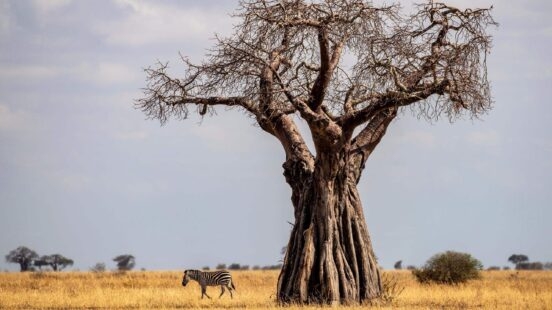
Ruaha National Park
For some of the most remote and untouched nature in Tanzania, head to Ruaha National Park. Here you’ll find lions, hyenas, wild dogs, leopards, cheetahs, antelope, zebras, elephants, giraffes and many other species, as well as abundant birdlife during the rainy season (especially from January to April). Despite its gigantic size, Ruaha attracts far fewer visitors than more well-known parks, making it the perfect choice for those seeking a more remote travel experience.

Mahale Mountains National Park
Mahale Mountains National Park is known primarily for its thriving population of chimpanzees – but it’s also home to several other species of primate, beautiful birds and aquatic animals that live in Lake Tanganyika. Its diverse landscapes and lack of roads make for a truly immersive travel experience. You can also visit the nearby Gombe Stream National Park (where Jane Goodall worked) and learn about both parks’ efforts to protect the native chimps.

Top Wildlife Species of Tanzania
This country boasts hundreds of types of mammals and reptiles, more than 1,000 different kinds of birds and many rare and endangered species. And beyond the obvious sightings on every safari wishlist, there are also plenty of lesser known – but still impressive – animals in Tanzania.
What’s the National Animal of Tanzania?
The national animal of Tanzania is the Maasai giraffe, which is larger and taller than other giraffe species, with darker and sharper markings. You can see Maasai giraffes across Tanzania in the Serengeti, Tarangire, Ruaha, Nyerere and other national parks. This species is sometimes also called the Masai giraffe or the Kilimanjaro giraffe.

The Big Five
The Big Five are probably the most iconic animals in Tanzania: the African lion, African elephant, African leopard, black rhino and Cape buffalo. Serengeti National Park and the Ngorongoro Conservation Area are among the best places to see these colossal creatures. For the highest chances of spotting all five in one trip, visit during the dry season from June to October.

Big Cats in Tanzania
Lions, leopards and cheetahs can be found all over Tanzania, especially in the Serengeti and Tarangire National Park. There’s nothing quite like witnessing the strength, elegance and speed of these sleek animals in person. And for an even more unique experience, visit Lake Manyara to catch a glimpse of its legendary tree-climbing lions.

Birdlife in Tanzania
Birdwatching enthusiasts will be awestruck at the dazzling diversity of birds in Tanzania, from bright pink flamingos to colourful endemic sunbirds and lovebirds. Some of the best places to see them are Tarangire, Lake Manyara and the Mahale Mountains. The wetter months from December to March may not be ideal for safaris, but they’re perfect for birdwatching.
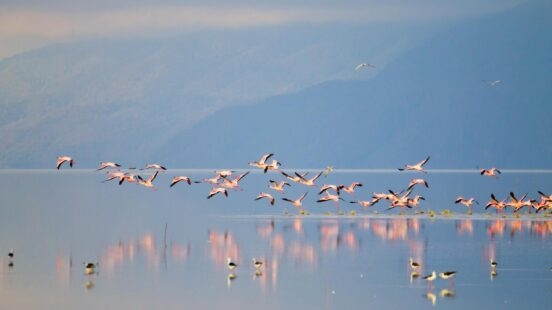
Coastal Wildlife
Tanzania is located on the eastern edge of Africa, with around 1,424 kilometres (885 miles) of coastline on the Indian Ocean – plus the gorgeous island of Zanzibar. Here you’ll find coastal birdlife and aquatic species like whale sharks, dolphins, manta rays and sea turtles. If you’re visiting Zanzibar between January and May, you might be lucky enough to see baby turtles hatching: an especially magical experience for a family trip to Tanzania.

Reptiles in Tanzania
Tanzania’s reptiles may not be the flashiest animals on most travellers’ lists, but they’re well worth your attention. Keep an eye out for crocodiles in Nyerere and Katavi National Park, but don’t overlook smaller species like chameleons and lizards. Five of the world’s seven species of sea turtles can also be found off the country’s coast, all of which are endangered.

Conservation Efforts in Tanzania
Tanzania has some truly impressive – and wonderfully successful – conservation programmes. Tourism plays an important role by incentivising the protection of the country’s wildlife and habitats and generating income to fund future initiatives. You can contribute directly to these efforts by staying at a safari camp or lodge that prioritises positive impact.
One such place is Chem Chem, an intimate lodge situated in the Kwa Kuchinja Corridor between Tarangire and Lake Manyara, which is firmly committed to safeguarding the area’s animals from poaching and hunting. It also operates the Chem Chem Association to support education, job creation and economic development in local communities.
At Ngorongoro Crater Lodge you can meet members of KopeLion: a conservation group that works to foster peaceful coexistence between lions and humans. And in the Serengeti, Lemala Kuria Hills Lodge sets a trailblazing example for reducing the environmental impact of safari tourism, with several innovative solutions to minimise its waste, emissions and energy use.
Finally, at Wilderness Usawa Camp, a mobile camp which moves with the seasonal migration, Wilderness Tanzania works with the authorities and local partners to protect the Serengeti National Park. They empower communities to reduce snares, poaching, and cutting down trees through formal training programmes which educate local children.
Whatever you want from your adventure in Tanzania, our travel designers are ready to help:





